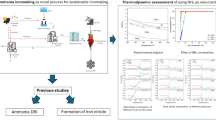Abstract
A certain quantity of iron was present in the waste acid leach copper smelting dust, which affects the quality of the copper and current efficiency. Elimination of iron and arsenic, the effects of various temperatures, times, H2O2 dosage, and initial pH were researched. The experimental findings indicated that the ideal conditions were 80°C, 3 h, hydrogen peroxide 6.5 times the dose of Fe2+ in the theoretical oxidizing solution, and initial pH of 4. Arsenic removal rate was 99.5%, while iron removal rate could be 98.99%. The solution’s iron concentration and arsenic concentration were both < 0.01 g/L under ideal circumstances. In addition, the morphology of the substances or elements involved in the precipitation of iron and arsenic was examined using XRD and thermodynamic studies, and the morphology of the precipitated slag was examined using SEM-EDS. These results show that hydrogen peroxide succeeded in removing arsenic and iron from the copper sulfate solution, and a pure copper sulfate solution was obtained.






Similar content being viewed by others
Data Availability
The data cannot be made publicly available upon publication because they are not available in a format that is sufficiently accessible or reusable by other researchers. The data that support the findings of this study are available upon reasonable request from the authors.
References
W.J. Liu, T.P. Hu, Y. Mao, M.M. Shi, C. Cheng, J.Q. Zhang, S.H. Qi, W. Chen, and X.L. **ng, Environ. Pollut. 306, 119391 (2022).
A. Sheoran and V. Sheoran, Miner. Eng. 19(2), 105 (2006).
G. Tamasi and R. Cini, Sci. Total. Environ. 327(1), 41 (2004).
H.M. Hu, Q.W. Zhang, X.W. Li, L. Wu, and Y.C. Liu, Sep. Purif. Technol. 248, 117021 (2020).
P. Asokan, M. Saxena, and S. Asolekar, J. Hazard. Mater. 137(3), 1589 (2006).
B. Oladipo, and T.V. Ojumu, Hydrometallurgy 221, 106144 (2023).
A. Ali, and R.A. Khan, Mater. Today Proc. 93, 302 (2023).
R. Alizadeh, F. Rashchi, and E. Vahidi, Waste Manag. Res. 29(2), 165 (2011).
J. Hoang, M.A. Reuter, R. Matusewicz, S. Hughes, and N. Piret, Miner. Eng. 22(9–10), 742 (2009).
Y.Y. Wang, H.F. Yang, W.H. Zhang, R.L. Song, and B. Jiang, Physicochem. Probl. Miner. Process. 54(2), 517 (2022).
S.K. Agarwal, M.M. Ali, A. Pahuj, B.K. Singh, and S. Duggal, Adv. Cem. Res. 27(5), 248 (2015).
P.T. Davey and T.R. Scott, Hydrometallurgy 39(10), 19 (2021).
R. Ram, L. Beiza, M. Becker, M.I. Pownceby, M. Chen, Y. Yang, S. Yang, and J. Petersen, Hydrometallurgy 192, 105261 (2020).
T.X. Nan, J.G. Yang, C.B. Tang, W.Z. Zeng, Q. Zhu, S.Y. Tang, and C.P. Fu, Hydrometallurgy 203, 105624 (2021).
F.X. Yang, Y.B. **ng, Z.G. Deng, C. Wei, X.B. Li, and M.T. Li, Int. J. Chem. Reactor Eng. 19(10), 1103 (2021).
T. Yue, H.S. Han, W. Sun, Y.H. Hu, P. Chen, and R.Q. Liu, Hydrometallurgy 165, 238 (2016).
C.X. Li, C. Wei, S.W. Yi, G. Fan, Z.G. Deng, and X.B. Li, Hydrometallurgy 189, 105112 (2019).
X.H. Peng, X.B. Li, C. Wei, Z.G. Deng, M.T. Li, and B. Yang, Miner. Eng. 186, 107769 (2022).
M. Ammar, S.A. El-Halim, H. Sharada, M. Fadel, and A. Yehia, Appl. Surf. Sci. 601, 154223 (2022).
Y. Yoon, B. Kim, and M. Cho, Sci. Total. Environ. 902, 166414 (2023).
Acknowledgements
This work has received support from The Study of the Phase Evolution and Mechanism of Anode Copper Impurity Precipitation and Its Role in the Formation of Core-Shell Anode Slime. Basic Research Project of Yunnan Province - General Program (No. 202001AT070089); Yunnan Ten Thousand Talents Plan Young & Elite Talents Project Fund (YNWR-QNBJ-2018-327); Study on the synergistic treatment of open-circuit arsenic and the preparation of high-purity copper by high-copper dust and waste acid, No. DNTY-JH-09-(2021)029.
Author information
Authors and Affiliations
Contributions
Weisong Cai: manuscript writing and editing-first draft. **aohua Yu: Review articles and propose revisions. Yan Lin: supervision and funding acquisition. Qingfen Shen: enterprise investigation. Hongkun Dai: resources. Yonggang Li: supervision.
Corresponding author
Ethics declarations
Conflict of interest
No potential conflict of interest was reported by the authors.
Additional information
Publisher's Note
Springer Nature remains neutral with regard to jurisdictional claims in published maps and institutional affiliations.
Rights and permissions
Springer Nature or its licensor (e.g. a society or other partner) holds exclusive rights to this article under a publishing agreement with the author(s) or other rightsholder(s); author self-archiving of the accepted manuscript version of this article is solely governed by the terms of such publishing agreement and applicable law.
About this article
Cite this article
Cai, W., Yu, X., Lin, Y. et al. Experimental Study on Separation of Iron and Arsenic from Copper Sulfate Solution. JOM (2024). https://doi.org/10.1007/s11837-024-06614-2
Received:
Accepted:
Published:
DOI: https://doi.org/10.1007/s11837-024-06614-2




